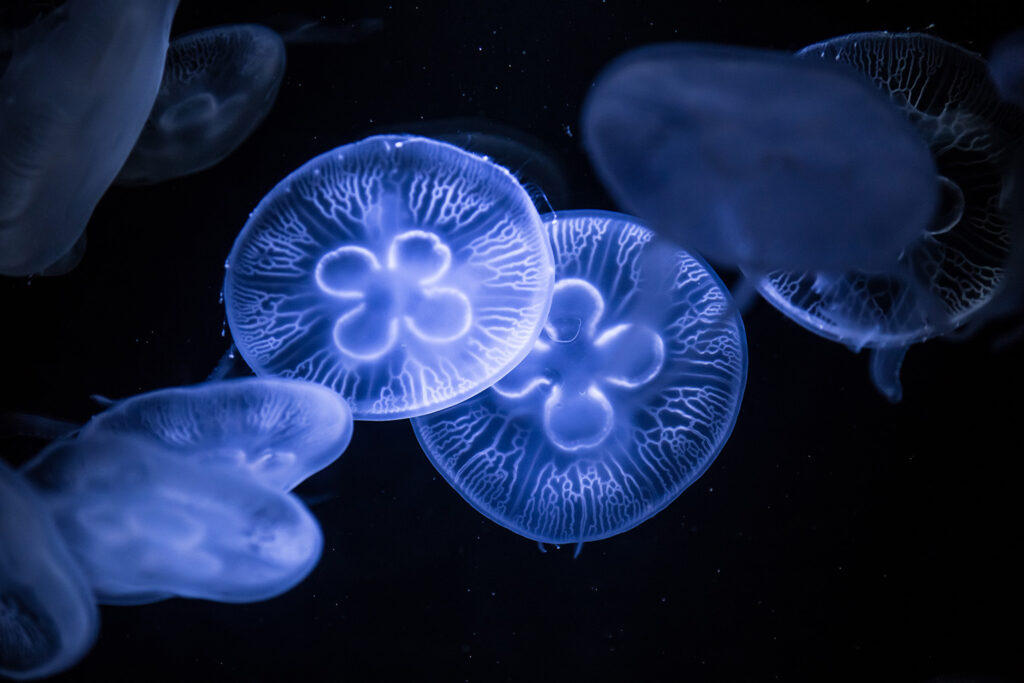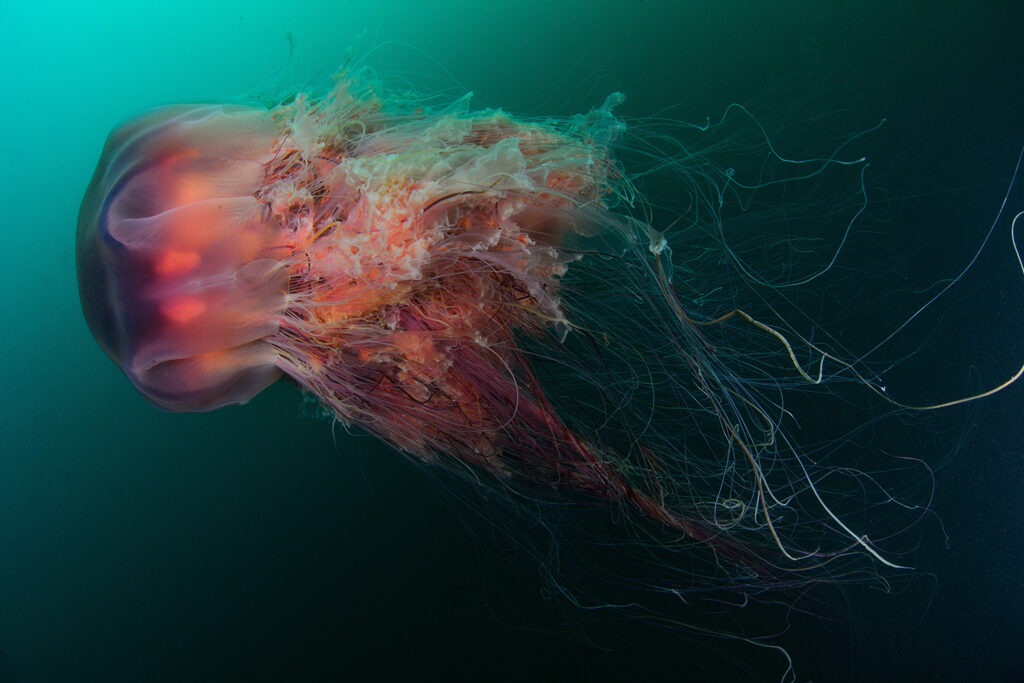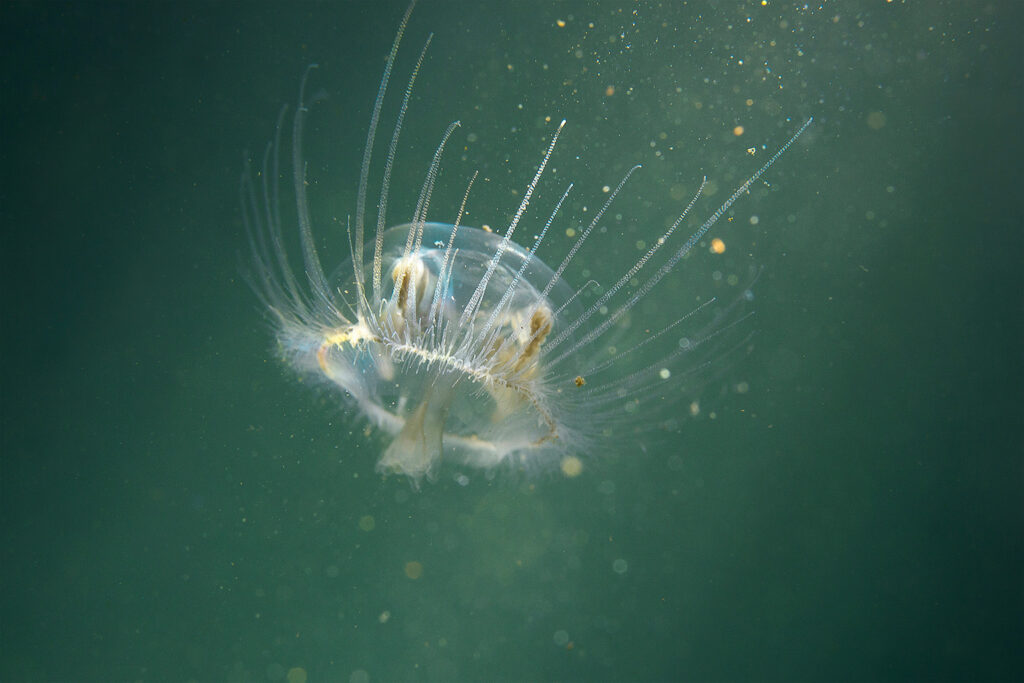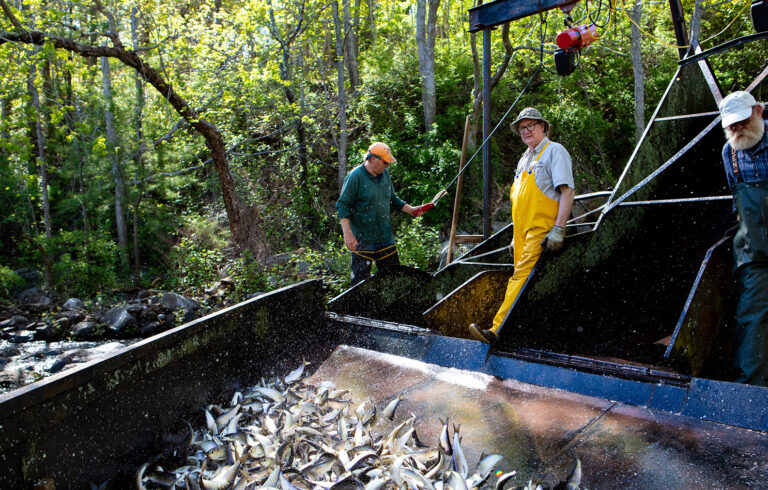Around dusk one summer evening more than 60 years ago, I was looking over the stern of an anchored lobster boat into flat calm water off Old Orchard Beach. I could just make out the sandy bottom, where I was hoping to spot crabs.
There was barely a swell, I remember. I was waiting on the boat for my father to return in his seaplane, which he used to spot herring for the sardine seiners.
He often left me on boats for hours at a time while he flew off peering into Casco Bay island coves, and I was left to the boyhood devices of my imagination to pass the time. I don’t know what we were doing as far south as York County that evening.
But just below the surface, translucent white moons about a foot in diameter began to appear. First one, then two, then I saw there was a whole smack of them floating at different depths.
Undulant, symmetrical, ghostlike. It was one of the most phenomenally beautiful sights I have ever seen in nature. At the age of about nine I had only the word “moon” as I gazed, but I felt like I was looking at an alien world. I was transported by the strangeness. And must have looked it.
“They’re jellyfish,” said one of the fishermen from behind me on the boat. He might have been trying to make sure I was still conscious, I don’t know. “White jellyfish. They won’t sting ya. Watch out for them red ones though.”

I came partway back to Earth. I already knew about red and white jellyfish. Friends’ experiences on beaches in Cape Elizabeth and Scarborough had revealed that picking up the red gelatinous blobs from the sand could result in painful stings, but no harm seemed to ensue from the clear or white ones.
When I recently described this event to Nick Record, a marine scientist at the Bigelow Laboratory for Ocean Sciences in East Boothbay, he replied it was a good bet the jellyfish I saw in the water off Old Orchard Beach were moon jellies (Aurelia aurita). The red ones on the beach were likely the lion’s mane jelly (Cyanea capillata). Both are commonly seen in the Gulf of Maine.
The moon jellies look round from the top and are a foot or so in diameter, just as I saw that long-ago evening. Lined around the edge of their bells are short, fine tentacles which they use to catch food such as zooplankton, mollusk larvae, crustaceans, even small fish. Contrary to our childhood folk wisdom, they do sting, but normally it’s practically unnoticeable to humans.
The lion’s mane jellyfish is a different story. It’s one of the largest jellyfish in the ocean, and is found more or less ubiquitously, where the moon jellies are mainly found near coastlines.
Dangling under each lion’s mane’s body are up to a thousand tentacles for food-gathering and defense. Jellyfish in the phylum Cnidaria (which includes lion’s mane and moon jellies) have a stinging mechanism in their tentacles.

In the lion’s mane jellies, the stinging cell, or nematocyst, is made up of a pouch with a tiny harpoon-like needle inside. Covering and inside the hollow needle is venom containing a complex of poisons including enzymes, proteins that create pores in cell membranes, and neurotoxins.
The cell is triggered mechanically, turning inside out and launching the needle with an explosive force of 40,000 Gs, according to marine biologist Lisa-Ann Gershwin in her book Jellyfish: A Natural History. Each thin tentacle on the lion’s mane jellyfish is up to 100 feet long and covered with as many as 250,000 nematocysts.
The sting is reportedly extremely painful to humans. It can lead within a few minutes to weakness, vertigo, nausea, headache, and muscle cramps, among other symptoms. Severe lion’s mane stings have led to difficulty breathing, tachycardia, muscle spasms, and stiffness of back and joints.
No human deaths from lion’s mane stings have been verified. But researchers do not rule out the possibility, because the symptoms of the sting are similar to symptoms of “Irukandji syndrome” stings administered by a genus of box jellyfish that have killed humans.
One of the most dangerous of these box jellies is the common Irukandji jellyfish (Carukia barnesi), whose body is only about a half-inch-long, but whose four nematocyst-armed tentacles reach up to 4-feet in length and are as fine as spider silk. The sting is reportedly not immediately noticed, but within a few minutes Irukandji syndrome symptoms, including severe back pain, difficulty breathing, and cramps appear, sometimes leading to heart failure, stroke, and sometimes death. Irukandji jellyfish live primarily in the tropics and Southern Hemisphere.
A few years ago an unusual number of sightings of lion’s mane jellyfish were reported along the southern Maine coast. Some of the creatures were as large as 6- or 7-feet across, prompting speculation that polluted and rapidly warming Gulf of Maine waters were providing ideal conditions for the red jellyfish to thrive.
For some years researchers have noticed larger, longer-lasting blooms of jellyfish more or less worldwide, and suggest that climate change may be causing improved conditions for jellyfish. But Record told a reporter that whether jellyfish populations overall are increasing is an “open question.” A recent review of jellyfish studies indicated the data on jellyfish blooms are very incomplete, and so any conclusions about their increasing are premature.
A “bloom” of jellyfish is a large, concentrated swarm. Record told me that some years ago his expeditions were hauling in large numbers of comb jellyfish (phylum Ctenophora) off Grand Manan Island and later in Harpswell Sound. For another example, researchers in 1976 scrambled to monitor a bloom of Nanomia cara, a cnidarian jellyfish, in the Gulf of Maine that was so large the jellies were clogging trawl nets of fishing boats off Massachusetts.

It was thought that so many Nanomia jellyfish were likely preying on herring larvae that the fishing boats’ catches could be affected. Most of the N. cara jellyfish, which are not uncommon in west Atlantic waters, were seen at depths greater than 125 feet, but the researchers, using a submersible, found significant numbers in shallower water too.
The researchers could not conclusively explain the cause of the N. cara bloom. Blooms probably occur when variable conditions—such as water temperature, presence of prey and predators, oxygen level, ocean currents, human overfishing, and development—combine in ways conducive to a jellyfish species’ life cycle.
Marine biologists will keep tabs on jellyfish blooms as the oceans continue to warm, since large blooms can diminish or even collapse fisheries, clog the cooling intakes of industrial plants, and pose a heightened threat to farmed fish, as in salmon hatcheries where Aurelia aurita has been shown to be an agent of gill disorder causing substantial damage to the fish.
Jellyfish are planktonic, meaning they’re aquatic organisms that for the most part drift rather than swim. They are extremely diverse in anatomy and life history, but fall into three phyla: Cnidaria, Ctenophora, and Chordata. The latter includes humans, fish, and salps, which are jellyfish-like creatures whose larvae have a sort of proto-spinal column (thus chordate); because of this notochord, some scientists do not consider salps jellyfish. The medusa, or free-floating adult form of most jellyfish range in length from about a half-inch to the lion’s mane’s 6 or 7 feet.
Some in their adult form, such as the Portuguese-man-of-war (Physalia physalis) seen floating on the surface or Nanomia cara, are not strictly speaking single animals, but colonies of “persons.” Each “person” performs a special function, such as food collection, digestion, defense, or reproduction.
Nanomia cara colonies observed in the 1976 bloom ranged up to nearly 12 feet in length. Colonies of the giant heart jelly (Praya dubia), a deep sea species observed practically worldwide, including the western Atlantic, can be more than 150 feet long.

The diversity of jellyfish reproductive strategies is mind-boggling. The life stages of most are made up of benthic (or bottom-dwelling) and pelagic (or drifting) stages.
Reproduction is accomplished sexually, asexually, clonally, by fission (similar to cell division), or in some cases even by the budding of new medusae directly from gonads.
Many jellyfish have sexual and asexual stages. Some transform between male and female. Some are hermaphrodites, meaning an individual has both male and female sexual organs; in one hermaphroditic species, an individual can fertilize its own eggs.
In a basic version of the reproductive cycle, the mature animal produces tiny larvae called planulae, which attach to the sea bottom. The planulae form polyps (which in some cases creep around the seafloor), and the polyps bud ephyrae (a second larval stage) that grow into adult medusae, with the familiar bell- or disk-shaped body and tentacles.
There’s a myriad of variations on this process, depending on whether the reproduction is taking place clonally, in which the polyps bud from stolons or runners similar to the runners of plants, or sexually through fertilization of eggs by sperm.
One extraordinary variation occurs in the cnidarian jellyfish Turritopsis dohrnii, a species found only in waters around Japan and the Adriatic Sea. Jellyfish bodies are generally fairly fragile, as sea creatures go.
When the T. dohrnii medusa is damaged by, for example, a sudden temperature rise, the body parts come apart, as in most jellyfish and other creatures. But in T. dohrnii, the cells do not decompose. Instead, they disperse, still living. While the damaged parts seem to disappear, the dispersed cells soon re-aggregate. Within a few days, stolons appear, made not of newly generated cells, but of the same cells from the damaged adult. The stolons bud polyps, and the polyps grow back into the original organism. The resulting animal is not an offspring; it’s made of the same cells that made up the original adult.
Marine biologist Gershwin notes that this is the equivalent of a frog dying and its cells re-aggregating into a tadpole. Other Turritopsis genus jellyfish in China have been studied and seen to go through similar reverse-aging processes. But Turritopsis dohrnii appears to be immortal.
Almost all jellyfish live in salt water, but a small handful of species are found in freshwater. The only freshwater medusa jellyfish seen in North America is Craspedacusta sowerbii, otherwise known as the peach blossom jellyfish. Its white, translucent bell is about the size of a quarter and is seen unpredictably in shallow lakes, streams, and ponds pretty much worldwide, though it’s native to the Yangtze River valley in China, where it got its common name.
It has an extremely adaptable reproductive cycle, and was first reported outside China in water lily tanks in London in 1880, probably having hitched a ride in aquatic plant shipments from China to England.

It was first spotted in North America in 1885. Retired Maine fishery biologist Matthew Scott wrote up the first report of C. sowerbii in Maine, on Androscoggin Lake, in 1963. Sightings have since been reported over much of the state in the last roughly 25 years. Sightings are sporadic and unpredictable because the medusa form does not bloom very often, and the polyp forms are difficult to locate even for biologists. Unlike some other cnidarians, C. sowerbii’s sting is not noticeable to humans.
It is noticeable to mosquito larvae, though. Gershwin says in her book that thought has been given to using C. sowerbii to control mosquito populations, but she admonishes: “Introducing alien species into virgin environments can be problematic, and time and again has proven disastrous the world over.”
The word “alien” is not out of place here. In a magazine essay on the world of jellyfish, marine biologist Record also uses it: “If space aliens ever decide to visit Earth … I doubt they will be stranger than our own gelatinous plankton.” He appreciatively observes they are “fascinating and beautiful.”
And, I might add, strange enough to make an otherworldly mark on the spiritual imagination of a nine-year-old on the coast of Maine.
Dana Wilde is a former English professor and newspaper editor whose books include Summer to Fall, Winter, and A Backyard Book of Spiders in Maine.




